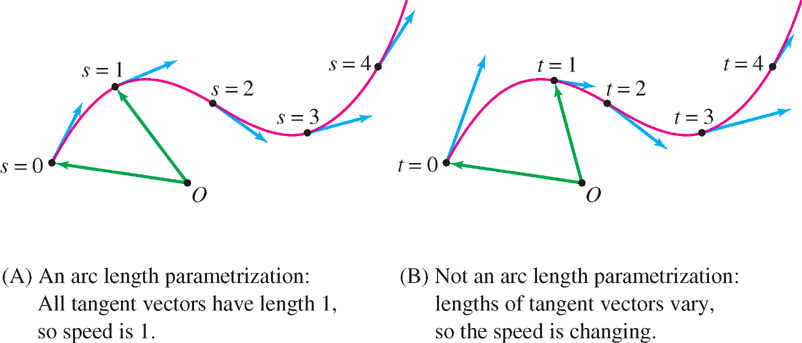Arc Length Parametrization
Keep in mind that a parametrization r(t) describes not just a curve, but also how a particle traverses the curve, possibly speeding up, slowing down, or reversing direction along the way. Changing the parametrization amounts to describing a different way of traversing the same underlying curve.
We have seen that parametrizations are not unique. For example, r1(t) = 〈t, t2〉 and r2(s) = 〈s3, s6〉 both parametrize the parabola y = x2. Notice in this case that r2(s) is obtained by substituting t = s3 in r1(t).
In general, we obtain a new parametrization by making a substitution t = g(s)—that is, by replacing r(t) with r1(s) = r(g(s)) [Figure 3]. If t = g(s) increases from a to b as s varies from c to d, then the path r(t) for a ≤ t ≤ b is also parametrized by r1(s) for c ≤ s ≤ d.

EXAMPLE 3
Parametrize the path r(t) = (t2, sin t, t) for 3 ≤ t ≤ 9 using the parameter s, where t = g(s) = es.
Solution Substituting t = es in r(t), we obtain the parametrization
r1(s) = r(g(s)) = 〈e2s , sin es, es〉
Because s = ln t, the parameter t varies from 3 to 9 as s varies from ln 3 to ln 9. Therefore, the path is parametrized by r1(s) for ln 3 ≤ s ≤ ln 9.
One way of parametrizing a path is to choose a starting point and “walk along the path” at unit speed (say, 1 m/s). A parametrization of this type is called an arc length parametrization [Figure 4(A)]. It is defined by the property that the speed has constant value 1:


743
In an arc length parametrization, the distance traveled over any time interval [a, b] is equal to the length of the interval:

Arc length parametrizations are also called unit speed parametrizations. We will use arc length parametrizations to define curvature in Section 13.4.
To find an arc length parametrization, start with any parametrization r(t) such that r′(t) ≠ 0 for all t, and form the arc length integral

The letter s is often used as the parameter in an arc length parametrization.
Because ∥r′(t)∥ ≠ 0, s(t) is an increasing function and therefore has an inverse t = g(s). By the formula for the derivative of an inverse (and since s′(t) = ∥r′(t)∥),

REMINDER
By Theorem 1 in Section 3.8, if g(x) is the inverse of f(x), then

Now we can show that the parametrization
r1(s) = r(g(s))
is an arc length parametrization. Indeed, by the Chain Rule,

In most cases we cannot evaluate the arc length integral s(t) explicitly, and we cannot find a formula for its inverse g(s) either. So although arc length parametrizations exist in general, we can find them explicitly only in special cases.
EXAMPLE 4: Finding an Arc Length Parametrization
Find the arc length parametrization of the helix r(t) = 〈cos 4t, sin 4t, 3t〉.
Solution First, we evaluate the arc length function

Then we observe that the inverse of s(t) = 5t is t = s/5; that is, g(s) = s/5. As shown above, an arc length parametrization is

744
As a check, let’s verify that r1(s) has unit speed:
